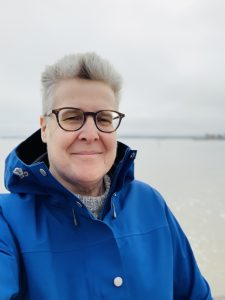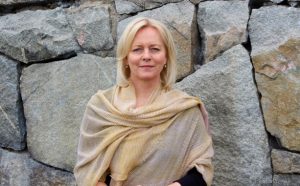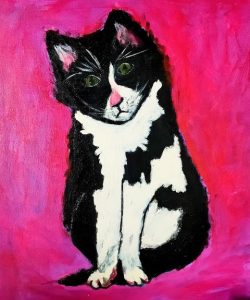by Kris Clarke, Mona Livholts & Christopher B. Sullivan
Considering the themes of queer grief and family violence in our research during this year of Covid-19 has made us reflect on the early days of the AIDS pandemic. An estimated 32 million people have died globally since the human immunodeficiency virus that causes AIDS was identified in the early 1980s. Initially seen as an illness that solely affected gay men, narratives of the early AIDS pandemic often focused on the social and family rejection that many seropositive gay men faced both when coming out and at the end of life. Contemporary dramatizations that deal with the AIDS pandemic, such as Tales of the City and It’s a Sin, highlight the significance of the story of ‘queer chosen families’ as a refuge of acceptance from the emotional violence of family of origin disconnection, especially during end of life.
The postwar generation of LGBTQ+ people in the United States faced many challenges and breakthroughs in coming out as their authentic selves. Western culture constructed homosexuality as pathological and criminal during much of the 20th century, propelling many LGBTQ+ people to large urban centers like New York and San Francisco where queer cultural enclaves thrived (Bérubé, 1990). However, the scars of societal stigma and family rejection created a collective generational trauma that was often internalized through self-shaming and dysfunctional behaviors (Bower et al., 2021). An archetypical gay coming out reflected the need to choose between family acceptance in an inauthentic life or family rejection when moving into an authentic life. Until 1971, homosexuality was viewed as a mental illness by the American Psychiatric Association. Further, non-heteronormative sexual relations and gender fluid presentation were largely criminalized by a variety of local, state and federal laws through statutes that banned dressing in the clothing of the ‘wrong’ gender or dancing with a same-sex partner. The open and accepting culture of Castro Street in San Francisco and Christopher Street in New York City drew thousands of LGBTQ+ people from across the US, and indeed around the world, fleeing homophobic small towns and unaccepting families.
The act of rediscovering hidden LGBTQ+ histories has been an important means of challenging the stigma and shame of erasure, pathologization and dehumanizationIn order to re-envision social justice, Plummer (2019, 156) argues for a recognition of ‘critical cultural memory’: of people, of groups, of places, of events and of states themselves.’ As social science researchers interested in the different aspects of memory, queer grief and memorialization, we have been discussing how the collective and specific personal memory of the AIDS pandemic informs concepts of queer grief and social injustice through the legacy of coping with social and family rejection. We have reflected on how critical cultural memory can thus challenge the emotional violence of family of origin estrangement and assert the value of queer relationships.
Recognition of grief and loss through memorials in the collective sphere creates its own challenges and opportunities. National memory politics tend to privilege elites and silence marginalized groups, but there is also agency in creating counter-memory and living transitional memorials (Livholts 2021). Erll (2020, 865) writes that pandemics have been less “tellable … than stories of heroic deaths on the battlefields.” Indeed, there are few public memorials that acknowledge the various epidemics that have ravaged the United States. There is one memorial bench in a Barre, Vermont cemetery built 100 years after the 1918 influenza pandemic that took the lives of 675,000 Americans. Though masculine representational themes of war prevail among American memorials, death due to epidemic has traditionally been viewed as a private family matter which often contests the inclusion of queer kinship.
The National AIDS Memorial Grove is nestled in a dell that was long derelict in San Francisco’s Golden Gate Park. Conceived by local residents in 1988, the Grove was recognized as a national monument by President Bill Clinton in 1996. Densely forested and scattered with small stones engraved with names and the ‘circle of friends’ memorial at the center, the Grove is a constantly metamorphosing site as the vegetarian grows and visitors leave mementos amidst the natural landscape. As a memory project, the AIDS Grove had several intentions. It is a site for traumatic private memories where people can come to remember friends, lovers and community members. Stories of being excluded from the funerals of partners by biological families were frequent during the height of the AIDS pandemic, which left loved ones with no place to mourn. At the same time, the Grove resists categorization of belonging to any particular group. Though gay men are the majority of the Board, the Grove has tried to decenter a white gay male narrative and be more inclusive of diverse stories of those lost to the virus (Gamson 2018). Nearly 40 years since the first cases of HIV were detected, notions of chosen family have been enshrined in patient rights throughout the United States. One of the lasting legacies of the AIDS pandemic is the assertion of the right to queer kinship. Next-of-kin is no longer automatically assumed to be the closest blood relative but can be designated by patients themselves. The body of law that has emerged since the height of the AIDS pandemic reflects a dramatic shift in rejecting the potential for a family of origin to exert emotional abuse or violence in situations of critical illness or death.
In their “The Central Valley HIV/AIDS Project” Clarke & Sullivan are currently exploring how people in Central California remember the AIDS pandemic of the 1980s and 1990s. Through interviews with long-term survivors, care workers, and family members, they are examining social narratives of grieving and loss that have rarely been publicly acknowledged. Clarke & Livholts continue working on studies at the intersection of memory and social work.
Authors:
 Kris Clarke is an Associate Professor of Social Work at the University of Helsinki. Her research interests center on decolonization, structural social work, and the significance of place and social memory. Clarke recently published Decolonizing Pathways towards Integrative Healing in Social Work with Michael Yellow Bird. She is currently working on a public history project documenting local stories of social work on the Social Work Routes podcast.
Kris Clarke is an Associate Professor of Social Work at the University of Helsinki. Her research interests center on decolonization, structural social work, and the significance of place and social memory. Clarke recently published Decolonizing Pathways towards Integrative Healing in Social Work with Michael Yellow Bird. She is currently working on a public history project documenting local stories of social work on the Social Work Routes podcast.
 Mona Livholts is Professor of Social Work, University of Helsinki. She works with global- and post anthropocentric perspectives in social work, intersectionality, and creative life writing methods such as memory work, diaries, letters and photography. Research topics include sexual violence, gender and space, narrative inequality and monuments, socially engaged art and environmental sustainability in urban spaces.
Mona Livholts is Professor of Social Work, University of Helsinki. She works with global- and post anthropocentric perspectives in social work, intersectionality, and creative life writing methods such as memory work, diaries, letters and photography. Research topics include sexual violence, gender and space, narrative inequality and monuments, socially engaged art and environmental sustainability in urban spaces.
 Christopher (Chris) Sullivan is an Associate Professor in the Department of Sociology at California State University, Fresno. His research focuses on understanding how processes of globalization influence social institutions – from large-scale financial institutions like the World Bank, to more local institutions centered around HIV care in California’s Central Valley. Sullivan lived and conducted research in mainland China for nearly 5 years. He has published research on Uyghur Muslim restaurants in the United States, and on the rise of accountability mechanisms that handle human rights grievances brought against international financial institutions.
Christopher (Chris) Sullivan is an Associate Professor in the Department of Sociology at California State University, Fresno. His research focuses on understanding how processes of globalization influence social institutions – from large-scale financial institutions like the World Bank, to more local institutions centered around HIV care in California’s Central Valley. Sullivan lived and conducted research in mainland China for nearly 5 years. He has published research on Uyghur Muslim restaurants in the United States, and on the rise of accountability mechanisms that handle human rights grievances brought against international financial institutions.
 Queering Migrant Family: intersection of migration, family practices and queer subjectivities
Queering Migrant Family: intersection of migration, family practices and queer subjectivities

 Kris Clarke is an Associate Professor of Social Work at the University of Helsinki. Her research interests center on decolonization, structural social work, and the significance of place and social memory. Clarke recently published
Kris Clarke is an Associate Professor of Social Work at the University of Helsinki. Her research interests center on decolonization, structural social work, and the significance of place and social memory. Clarke recently published  Mona Livholts is Professor of Social Work, University of Helsinki. She works with global- and post anthropocentric perspectives in social work, intersectionality, and creative life writing methods such as memory work, diaries, letters and photography. Research topics include sexual violence, gender and space, narrative inequality and monuments, socially engaged art and environmental sustainability in urban spaces.
Mona Livholts is Professor of Social Work, University of Helsinki. She works with global- and post anthropocentric perspectives in social work, intersectionality, and creative life writing methods such as memory work, diaries, letters and photography. Research topics include sexual violence, gender and space, narrative inequality and monuments, socially engaged art and environmental sustainability in urban spaces. Christopher (Chris) Sullivan is an Associate Professor in the Department of Sociology at California State University, Fresno. His research focuses on understanding how processes of globalization influence social institutions – from large-scale financial institutions like the World Bank, to more local institutions centered around HIV care in California’s Central Valley. Sullivan lived and conducted research in mainland China for nearly 5 years. He has published research on Uyghur Muslim restaurants in the United States, and on the rise of accountability mechanisms that handle human rights grievances brought against international financial institutions.
Christopher (Chris) Sullivan is an Associate Professor in the Department of Sociology at California State University, Fresno. His research focuses on understanding how processes of globalization influence social institutions – from large-scale financial institutions like the World Bank, to more local institutions centered around HIV care in California’s Central Valley. Sullivan lived and conducted research in mainland China for nearly 5 years. He has published research on Uyghur Muslim restaurants in the United States, and on the rise of accountability mechanisms that handle human rights grievances brought against international financial institutions.